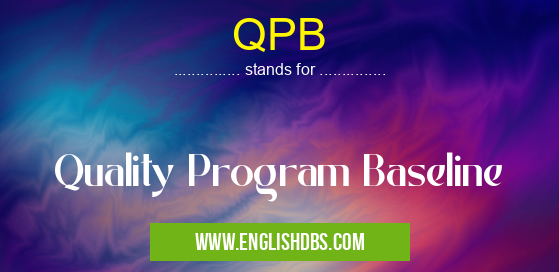What does QPB mean in GENERAL
The Quality Program Baseline (QPB) is a tool and process used to systematically ensure that quality standards are met in any given project. Originally developed as an approach to managing large, complex and ever-changing multi-stage projects, QPB enables the proactive identification and mitigation of risks, while providing oversight into project progress and performance. This process brings together all stakeholders - including suppliers, customers and internal teams - to ensure that desired outcomes are achieved.

QPB meaning in General in Business
QPB mostly used in an acronym General in Category Business that means Quality Program Baseline
Shorthand: QPB,
Full Form: Quality Program Baseline
For more information of "Quality Program Baseline", see the section below.
Benefits of QPB
Using the Quality Program Baseline has several distinct advantages. Firstly, it allows organizations to proactively mitigate risk by establishing clear objectives and requirements from the start of a project instead of waiting until after problems have already occurred. Secondly, it provides detailed insight into the current health of a project enabling quick corrective action when needed. Furthermore, it reduces costs associated with waste due to rework caused by quality issues; since issues are identified faster they can be addressed quicker resulting in fewer resources being spent correcting errors post-delivery or launch. Finally, having all stakeholders involved under one system ensures accountability across all levels resulting in better overall collaboration and higher customer satisfaction rates due to improved product/service delivery timescales and increased confidence in quality assurance measures implemented across the organization.
Essential Questions and Answers on Quality Program Baseline in "BUSINESS»GENERALBUS"
What is the Quality Program Baseline?
The Quality Program Baseline (QPB) is a management control system used to ensure the quality of deliverables across projects. It contains documented standards, procedures, and protocols which can be referenced during the development process to ensure products are consistent with stakeholders' needs.
How does the QPB help improve product quality?
The QPB helps manage quality by establishing standards that teams can refer to in order to ensure they follow the same processes throughout all stages of product development. It also helps organizations track performance, identify areas for improvement, and avoid costly errors that can arise when performing routine tasks.
Why is having a QPB important?
Having a QPB allows organizations to build consistency into their product development processes and establish best practices for assuring product quality. The baseline will help organizations save time and money by preventing costly mistakes from occurring due to inconsistencies in how teams approach tasks or adhere to standards or protocols.
What information should be included in a QPB?
A good quality program baseline should include clear documentation of standards, processes, protocols and roles & responsibilities associated with delivering products according to stakeholder needs. This should also include guidance on measuring performance, tracking changes and identifying areas for improvement.
What are some advantages of having a QPB?
Some advantages of having a QPB include improved transparency between teams; reduction in errors due to having defined and consistent processes; better project timelines due to fewer delays caused by discrepancies; improved cost-effectiveness due to fewer rework cycles; reduced risk of project failure due to better communication between team members and stakeholders; as well as improved customer satisfaction from higher-quality products delivered according to expectations.
How often should I review my Quality Program Baseline?
It is recommended that organizations review their Quality Program Baseline on an annual basis or whenever there are significant changes made within their organization's product development lifecycle. This will ensure that any changes made to processes, protocols or standards are captured within their Quality Program Baseline in order to continue achieving peak performance.
Who should be involved in creating a QPB?
All relevant stakeholders, including senior management, engineers/technicians and customers/users, should be involved when creating a Quality Program Baseline in order to reach agreement on what standards need documenting, how they will be implemented and measured over time. Additionally, project managers should also play an active role in the creation process so they understand expectations for achievement at each stage of project delivery.
How do I create an effective Quality Program Baseline?
When creating an effective Quality Program Baseline you need have full understanding of your organization's current processes and capabilities as well as any existing compliance regulations you must adhere too. Additionally you need input from user groups regarding what features need tracking during testing/implementation stages for success measurement later on down the line. The last step is ensuring roles & responsibilities are clearly set out amongst all stakeholders associated with delivery before documenting all steps taken towards achieving desired outcomes.
How do we measure success against our Quality Program Baseline?
Measuring success against the established QPB begins with following set procedures & standards throughout all stages of project delivery while keeping track of progress & completion rates relative those procedures & standards along with customer feedback at launch phase - Doing this helps determine if your team is conforming effectively towards reaching stated goals every step along way leading up successful end-to-end delivery.
Final Words:
The Quality Program Baseline is an effective solution for managing the quality of products or services throughout their life cycle while reducing long term costs associated with quality control measures through proactive risk mitigation strategies. By bringing all stakeholders together under one unified system it ensures greater accountability which increases customer satisfaction due to improved delivery timescales along with increased confidence thanks to rigorous testing procedures implemented from the beginning of any given project.
